Mastering Tempura Batter: The Secret to Perfectly Crispy Tempura
How do you make the perfect tempura? It starts with the batter! Regardless of the type of tempura dish you make, your batter must be consistently good. This is your chance to learn how to always get this complex Japanese mixture right!
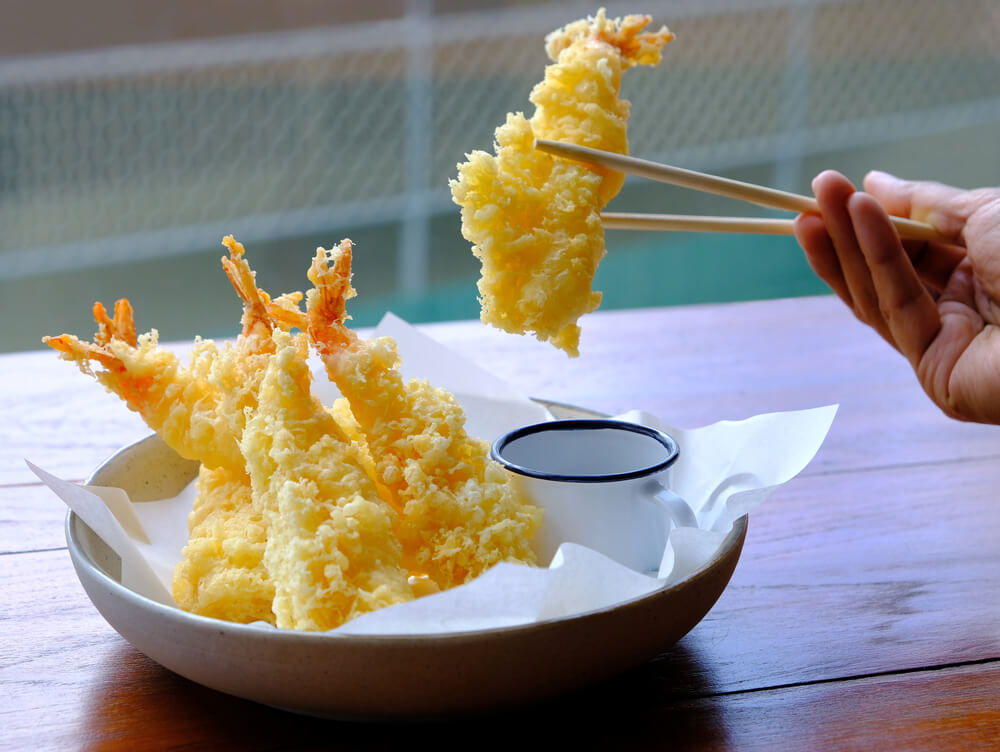
Introduction to Tempura Batter: The Foundation of Crispy Delights
Tempura batter is made from a mixture of egg yolk, cold water, and flour. It requires less oil than conventional batter and does not create crumbs. This kind of batter is popular in Japan, as it’s the backbone of all tempura dishes. Making tempura involves deep-frying seafood and vegetables coated in a special batter. The special coating is called tempura batter. Although the core ingredients of a tempura dish can vary, the only constant is the batter. It is thin, crispy, and incredibly delicious when done right.

There are dozens of different kinds of tempura, depending on their ingredients. You can make tempura with eggplant, fish, chicken, shrimp, mushrooms, okra, carrots, squid, and other ingredients. The fact that they all use the same batter is a clear indication of its crucial role in creating crispy tempura dishes. It’s little wonder that the mixture is so popular in Japan.
A normal batter won’t produce the same results. The tempura batter is lighter and crispier. It also has a unique recipe and preparation method.

The Classic Tempura Batter Recipe: A Step-by-Step Guide
Although there are a few variants, we believe that traditional tempura is the best. Let’s explore an easy tempura batter recipe. If you find it complex for the first time, worry not. It becomes easy when you get the hang of it.
To get started, you need to have the following ingredients:
-
Bowl of iced water
-
Egg
-
Cup of flour (all-purpose or cake flour)
Now that you have all of that ready, keep in mind that you should store the flour and water in the refrigerator and only take them out when you’re ready to mix. Alternatively, you may dip ice cubes in the water. Before mixing, remember that the appropriate ratio of flour to egg and water (flour: egg + water) is 1:1. That means that the liquid should be just as large as the solid for the mixture to work. Also, make sure you have prepared all the tempura ingredients (fish, vegetables, hot oil, etc.) before you start to make the batter. You need it cold for the best results.

Let’s learn how to make tempura batter. Follow the steps below:
-
Gather the cold ingredients.
-
Sift your flour 1–2 times. This will help to remove clumps and make it lighter.
-
Pour the contents of the egg into a bowl and beat it until they mix.
-
Pour the cold water into egg mixture.
-
Pour flour into the cold water + egg mixture.
-
Mix the content with a pair of chopsticks for 15 to 20 seconds. It’s okay for it to have some lumps. Try not to overmix, as it will lead to gluten formation, which stops the tempura batter from reaching a light texture.
Ideally, you want to use your ready batter to coat your tempura base and deep-fry right away. If you can’t do that, we recommend that you place the batter in the refrigerator to keep it cold. However, tempura batter should only be refrigerated for a few minutes.
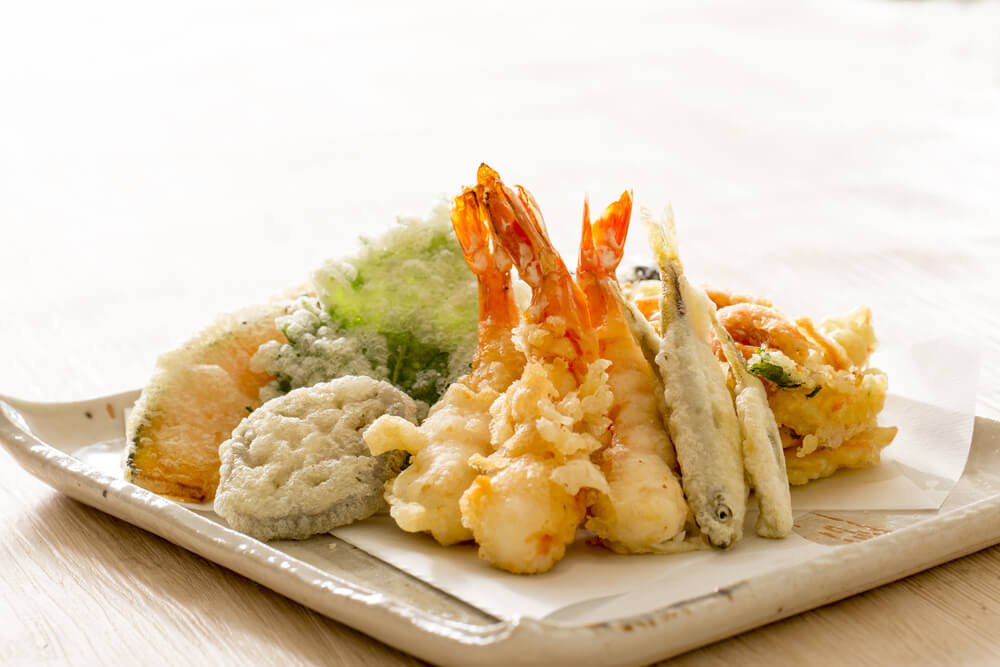
Dipping Sauce Pairings: Enhancing Tempura with Soy Sauce-Based Dips
Tempura dishes are best served with a special dipping sauce, also called tentsuyu. This typically consists of Japanese dashi, soy sauce, mirin, and sugar. You can make tasty tentsuyu with only those four ingredients; however, there are several optional ingredients. These include:
-
Daikon radish and ginger
-
Sesame oil
-
Bonito flakes
-
Kewpie mayonnaise
-
Wasabi
-
Matcha
Even if you experiment with different options, the majority of existing recipes are soy sauce-based. Learn how to make traditional tempura dipping sauce (dashi, mirin, sugar, and soy sauce), and you should be fine. You can follow the steps below:
-
Gather dashi soup stock, mirin, and soy sauce in the following ratio, respectively: 4:1:1.
-
Pour all the ingredients into a sauce pan and add half a tablespoon of sugar.
-
Mix the content well.
-
Place the pan over medium heat and allow the mixture to boil over.
-
Remove from heat and let it cool. Your tentsuyu will be ready to serve with your tempura. You may add daikon radish or other optional ingredients for extra flavor.
Do you have to make dashi soup stock from scratch? Absolutely not! You can buy instant dashi powder or premade soup mixes on Bokksu Market.
The tempura dipping sauce adds an extra layer of tastiness to the dish. You’ll enjoy it more when your tempura is crispy and light. If your tempura isn’t crispy enough, you may have overmixed the batter or the water wasn’t cold. How you deep-fry the tempura after coating it with batter may also affect its crispiness.

Deep Fry Techniques: Achieving the Perfect Crispy Tempura
Be careful while deep-frying tempura because one mistake could mess up your results. Here are some tips and techniques to help you:
Choose the Right Oil: Use oil that can handle the high temperatures of deep-frying without smoking (high smoke point). Most people use sesame oil for tempura. However, there are other options, including: canola oil and vegetable oil. Refined oil is better for tempura than unrefined ones.
Don’t Overcrowd the Pot: You might be tempted to save time by pouring all of the ingredients into the pan rather than in batches. Don’t do it! Overcrowding the pot is bad for your tempura, as it keeps it from frying properly. The amount of ingredients per batch shouldn’t cover more than half of the oil in the pot.

Don’t Leave Crumbs: Be sure to remove crumbs after each batch. They could attach to a new batch if you don’t clear them out.
Keep temperature steady: Ideally, you want to maintain the same temperature throughout the deep-frying process. Also, you should turn each piece regularly to ensure they fry evenly.
Keep batter away from the stove: Remember that you want your batter cold, so don’t keep it close to the fire while cooking. It will become too hot.
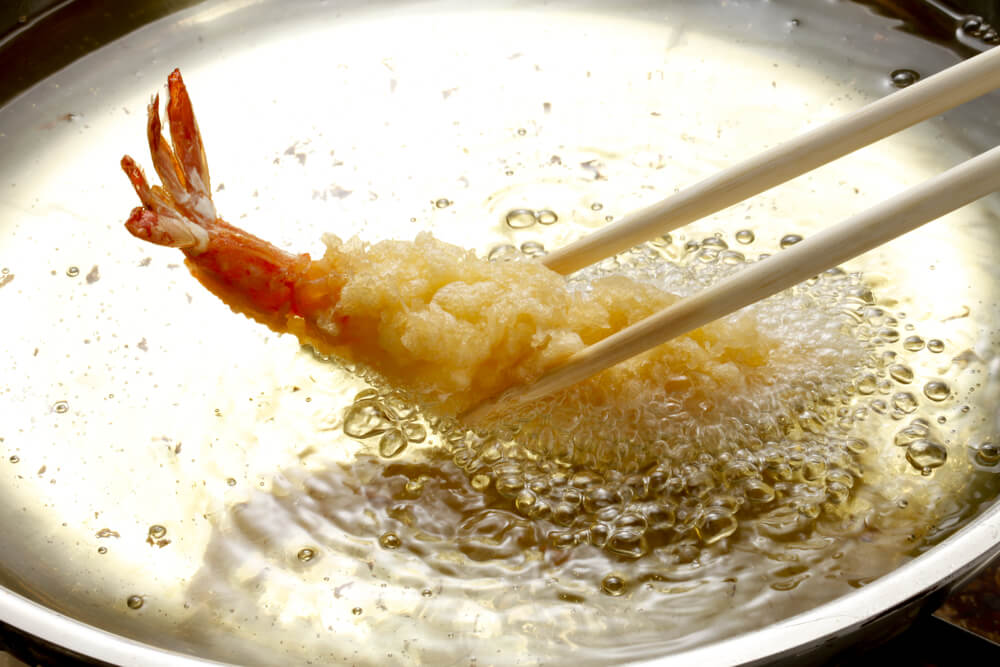
Choosing the Right Ingredients: Cake Flour and More
To make the best tempura batter you can, you need to have the right ingredients. We’ve had a lot of people ask: What is the best flour for tempura batter?
To make crispy tempura batter, use low-protein flour. It is low in gluten, a protein that negatively affects the texture of the batter. Cake flour is one of the best for making the batter. All-purpose flour works too, but not as well. If you’re using the latter, adding corn starch or potato starch could improve crispness. A tablespoon or two of starch per cup of flour works best.

Gluten is the enemy of a good tempura batter. That’s the major reason cold water is a requirement for it, as it slows gluten formation from protein. Here’s a trick: to slow gluten formation even further, add a bit of vinegar to your cold water.
Shrimp Tempura: A Classic Favorite
Shrimp tempura is arguably the most popular of them all. There are many seafood variants but Ebi no Tempura, as it’s fondly called in Japan, is a classic favorite. To prepare it, you would need tempura batter, large shrimp, and oil.
Start by peeling the shrimp. You can remove the tail, but we recommend leaving it on. Straighten and then dry the shrimp by patting them with a paper towel. This will remove moisture that could make the tempura soggy later on.
Next, heat up 3 cups of oil to a temperature of 160-180°C. This may seem hot but trust us, there’s a good reason for this, which we’ll discuss later in this post. Use a thermometer to measure the temperature, if possible. An alternative temperature check is to dip chopsticks in the oil. If you notice bubbles next to the tips, then the oil is hot enough. The best time to prepare tempura batter is while the oil heats up.
Although this is optional, we recommend that you dust the shrimp lightly with some corn or potato starch for a crispier result, as it helps the batter stick to the shrimp. If your batter is ready, dip each shrimp in it, allow it to drip for 2 seconds, and then add it to the hot oil (over medium to high heat).
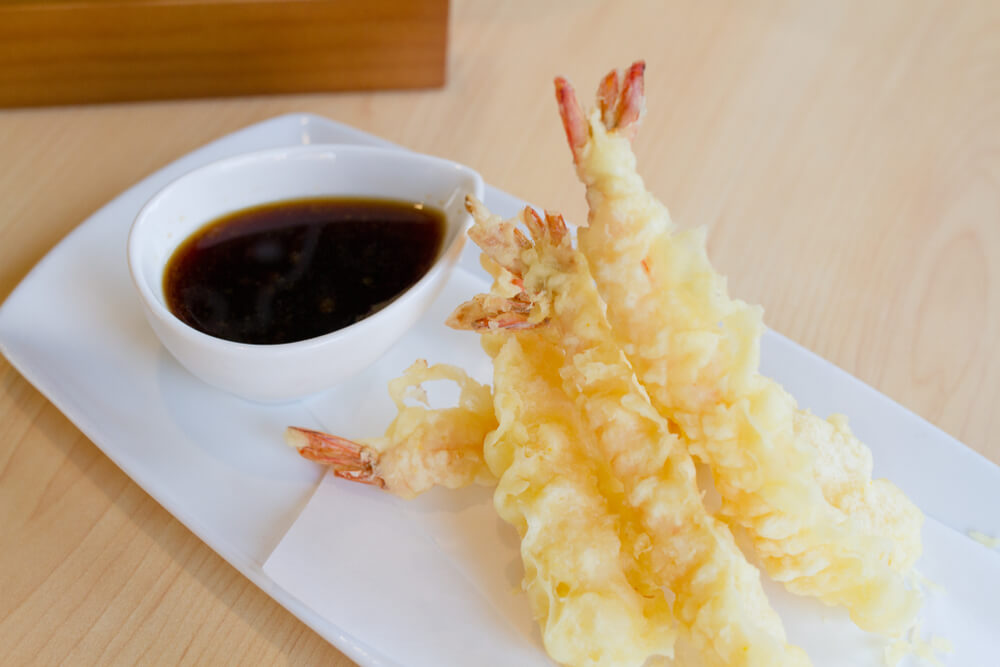
Let the tempura shrimp deep-fry for 2 to 3 minutes. You will soon notice that the color turns golden brown. That is your cue to take it out. You can now serve it with dipping sauce and enjoy!
Vegetable Tempura Variations: From Sweet Potatoes to Green Beans
Vegetable tempura are just as beloved as their seafood counterparts. The vegetables mainly used for tempura include sweet potatoes, green beans, shiitake mushrooms, egg plants, carrots, okra, lotus roots, kabocha squash, and bell peppers. Let’s explore our quick guide on how to make vegetable tempura using sweet potatoes as an example.
Start by cutting your sweet potatoes into 6 mm rounds. Then soak them in water for between 15 and 30 minutes to reduce starch. Take the slices out and pat them with a towel to dry them. Prepare and dry other ingredients, such as kabocha squash, lotus roots, mushrooms, and the like. Ensure that you dry all of these ingredients.
Now it’s time to heat your oil to 160°C (more on this soon). Use this time to make your tempura batter. Dip each vegetable in it, allow it to drip for 2 seconds, and then add it to the hot oil (over medium to high heat). Deep-fry root vegetables for 3-4 minutes and non-roots for 1-2 minutes.
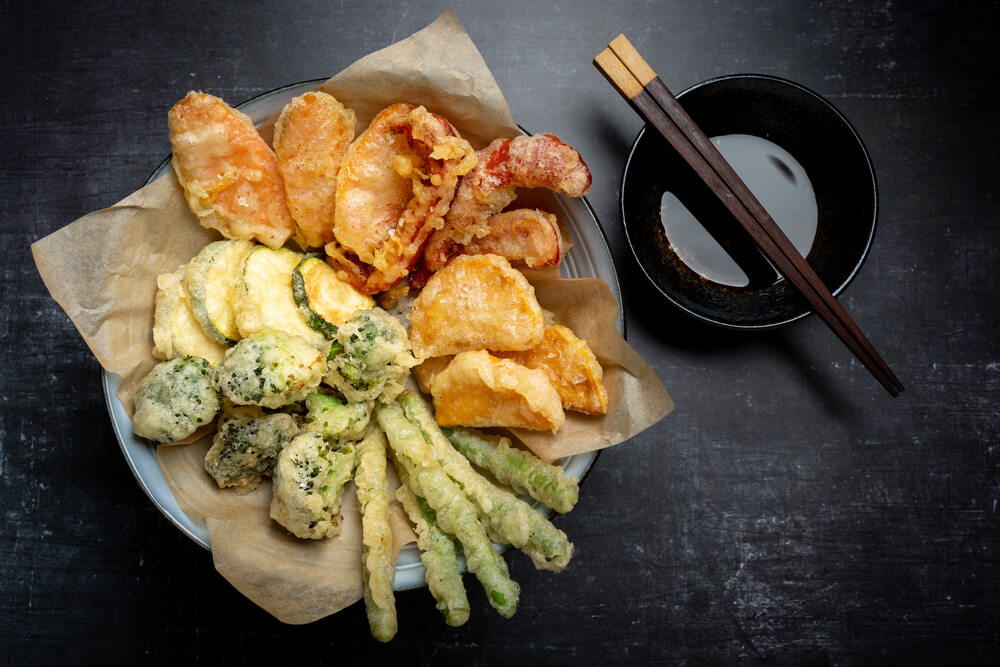
The Science of Hot Oil: Temperature Control for Crispy Batter
160-180°C is the ideal temperature for cooking tempura. But why so hot? Well, if your oil isn’t hot enough, your tempura will soak it up and the result won’t have the coveted crispy texture. There’s a science to it. Because water boils at 100°C, heating the oil to 160°C+ will produce steam bubbles around the batter-coated ingredients. These bubbles keep the oil from penetrating the inside of the tempura and causing it to be too oily. Hence, the hot oil keeps the food crispy!
Homemade Tempura Batter vs. Store-Bought: Pros and Cons
Now that you know how to make tempura batter, do you have to do it every time you crave the dish? The short answer is "no." Store-bought tempura batter mix is an alternative. This is a powder that already has all of the major ingredients you need to make tempura batter. However, you still have to mix it with cold water to make the batter.
Store-bought batter is easier to make and takes less time. You can save about 10 minutes from the time you’d use to beat eggs and measure ingredients. Partially used mixes store better than left-over homemade batter. Also, some mixes, like the Dynasty Tempura Batter Mix at Bokksu Market, are gluten-free, which is good news for tempura makers.
Homemade tempura allows you to experiment a bit more. For example, you may prefer to make egg-free tempura.
Advanced Tempura Techniques: Elevating Your Deep-Fried Creations
We’re sure you’ve learned a lot so far, but here are a few more tips to elevate your tempura-making skills:
-
Mixing batter with chopsticks instead of whisks lessens the chances of overmixing.
-
An alternative to tentsuyu is flavored salts (matcha, curry, yuzu, etc.)
-
After whisking your egg, remove any foam that appears in the content to reduce the risk of burning the batter.
-
Put some ice cubes in the batter bowl if you’re making a large amount. This will keep it cold.
Conclusion: The Art of Tempura in Your Kitchen
Learning how to make tempura will not only give you access to another tasty recipe but will also endear you to your Japanese friends and family, as it’s a beloved dish in Asia. A lot of these tips will help you make other types of batter, many of which are not as complex.
Whenever you’re in too much of a hurry for homemade tempura, you can always visit Bokksu Market for a quick fix. Premade goodies like Menraku Ramen Bowl: Spicy Sesame and GGE Ramen Crackers: Mexican-Style Spicy will satisfy your needs in a few minutes. Enjoy!
Author Bio








